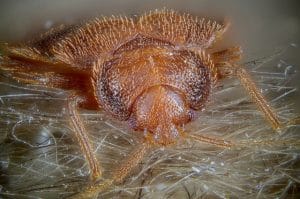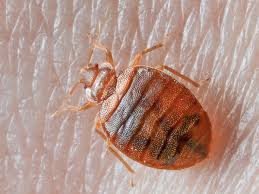If you’ve purchased a brand new dog bed and want to make sure it stays in tip top condition then you may have wondered if your dog bed can get bed bugs and if so can your dog spread them to your bed or can your dog get them from your bed and spread it to their own dog bed. Phew! Anyway, here at Jug Dog we are going to help shed some light on bed bugs in your pooches life.
Can and Do Bed Bugs, Carry, Bite and Live on Dogs?
Bed bugs are mostly known for their unhealthy habit of biting people, but what about our canine companions? Do bed bugs actually attach to dogs? Do bed bugs bite dogs? Do bed bugs travel on dogs and can you get bed bugs from a dog?
Sorry to be the bearer of bad news but the answer to most of your questions is – yes.
In this article, JugDog.co.uk is going to cover every aspect and cause like why this insect preys on puppies, whether dogs can carry bed bugs and of course – how to handle an infestation.
“Bedbugs are small blood-sucking insects that live in cracks and crevices in and around beds. They crawl out at night and bite exposed skin to feed on blood” says the NHS website. Their scientific name is Cimex lectularius. Bed bugs typically are found in human beds and want to feed on human blood.
Bed bug infestation and bites are mostly harmless if dealt with quickly but they are notoriously difficult to get rid of and if their bites go untreated can lead to infections.
What are bed bugs, exactly?
Bed bugs are members of the parasite mafia and their preferred choice of food is blood from warm-blooded animals. While their main source of nutrition is humans, they wouldn’t miss an opportunity to pounce on your dog or cat.
However, don’t assume that you’ll just find a bed bug joyfully strolling down your arm or on your pet’s paw. No, these bloodsuckers attach to their host for a few minutes only to have their dinner and then they hit the road. Bed bugs can transfer and travel extremely well.

In terms of visual characteristics, the parasite definitely does not look good.
Adult bugs are about 5-7 mm long and flat. If you want to have an exact idea about their length, just imagine an apple seed. Their shape and size make it extremely easy for them to hide practically anywhere.
And when we say anywhere, we really do mean it – in bed frames, inside the rips of old wallpaper and even in that one screw located in your electrical socket.
How do you get bed bugs in the first place?
This sort of parasite has a strong desire to travel. Many people unknowingly bring back bed bugs with their luggage after a holiday, as they’ve stayed in an infested hotel, for example.
You see, a lady bed bug is capable of laying anywhere from 2 to 5 eggs per day, which means that if you bring back even a single representative of this parasite family in your suitcase, you can end up with a severe infestation.
According to many studies, including the 2015 Bugs Without Borders Survey, bed bugs like to move house and settle in single family homes, apartments and hotels.
Again, these are just their most popular choices. The parasite can be also found in college dorms, hospitals, nursing homes, and even on public transport.
You read this right – there are bed bugs riding the tube. If we can call this sort of vermin one thing, that would be a survivor. The bloodsuckers can go months without eating anything and can live through the lowest temperatures.
What are the signs of a bed bug Infestation?
Here is a list of some of the signs to look out for if you suspect that you’ve become a victim of a bed bug infestation:
- Blood spots scattered on your bedding;
- Rusty stains caused by bed bug poop on your mattress, sheets or walls;
- Shells from the bug’s babies or shed skin around the bloodsucker’s hiding places;
- A nasty smell from the parasite’s scent glands and more.
How do you get rid of bed bugs on your dog?
Overall, bed bugs are hard to get rid off. That’s mainly due to the fact that it just takes 2-3 bugs to end up with a whole infestation and because they hide in tough-to-reach areas.
- The easiest thing to and the first thing you should do is to get rid of the existing dog bed and buy a new one.
- Step two is to clean your dog using anti-flea shampoo or better off, a bed bug shampoo for dogs.
- Step three is the clean your dog’s general living space.
- Step four is to call exterminators for a professional bed bug treatment
Generally speaking, getting rid of dog bed bugs follows the same rules as getting rid of normal bed bugs.
Bed bug shampoos for dogs:
The first step in getting rid of bed bugs is to locate their lair.
Generally, their first choice will be your bedroom area, but you can find the bloodsuckers scurrying around your living room, as well.
Keep in mind that a bed bug infestation can start in just one room and then, spread in your entire house in the blink of an eye.
Most bed bug infestations begin in rooms with soft furniture, so the treatment must start from there.
Wash all of your bedding, encase your mattress in a special protector, vacuum the whole area to remove the adults and apply a chemical treatment to destroy their eggs. If the infestation has moved to your dresser, for example, you need to repeat the process again. If you’re using dog harnesses, get rid of those and choose a new harness.
You can find a wide range of products, designed to kill bed bugs. We don’t advise investing in a fogger, because it won’t reach the areas, in which the pest tends to hide. Sprays are a good idea, as they will be able to demolish the bugs on the spot. Before you try any exterminating product, make sure to read the instructions on the label.
Again, we highly recommend hiring a professional bed bug exterminator to take care of the infestation.
Do bed bugs bite dogs?
Yes and.. no.
Dogs (and most pets like cats etc) are not bed bugs natural targets and they’re not engineered to climb around fur and hair and the canine’s blood just isn’t their top choice. It would be unlikely that your dog has a bed bug problem but not your own bed(s). If you’ve got bed bugs then maybe they could, too.
If your dog does have bed bug issues, though, their symptoms would be similar to human beings:
- itchy red marks on the skin
- may cause a rash or fluid-filled blisters
As we said earlier in this article, yes, bed bugs do indeed bite dogs. And canines aren’t the only ones that the parasite likes to munch on. Even your cat, bird or pet mouse can become a victim of the bloodsuckers’ attack.
Can my dog carry bed bugs without me knowing?
Don’t worry, the pest doesn’t travel by dog, however, it won’t think twice about making your pet’s bedding a new home for hundreds of bed bug babies.
What are the signs of bed bugs on dogs?
Bed bugs won’t cause your dog to smell after being outside but you could spot the signs of bites. The first thing you should look out for are signs of irritation, such as scratching, biting and licking. Bed bug bites don’t itch only on human skin, your four-legged friends can also suffer from the annoying red bumps.
The second thing you should investigate is your pet’s bedding. Check for dark spots. If you find any, they are either marks from the dog’s dried blood, caused by the bite or bed bug poop.
Next on the list is shed skin. Examine your dog’s sleeping area for any bed bug exoskeletons. They look completely like the parasite, just empty and translucent. While looking for the crunchy skins, check for eggs, as well. They are quite small and very hard to find, still, if you spot any, there is definitely a bed bug family living in your pet’s bed.
What do bed bugs bites on dogs look like?
If you suspect that your pet has been bitten, check his belly and limbs for small red pimples. Bed bugs leave their marks in small groups or in a straight line.
The problem is that if your pet has fairly long fur, it would be a bit more difficult to spot the bites. If your canine friend starts to scratch himself more than usual, a bed bug rash may appear due to irritation.
The last sign of bed bugs on dogs is actually seeing a live specimen, crawling around your canine friend’s sleeping place. So, if you see a moving apple seed on your pet’s pillow, you are most definitely looking at a bed bug going out for dinner.
Can a bed bug make me or my pet ill?
Generally, bed bug bites aren’t dangerous for neither your health nor your pet’s. We are most definitely not saying that it’s a good thing to get munched on by a parasite, but just that they don’t carry any life-threatening diseases.
However, there are cases, in which people or their pets develop welts or lesions, caused by an allergic reaction to the bite.
If we have to sum it up: You won’t get Bubonic plague from bed bugs, but you’ll definitely have a lot of “fun” thanks to the itching bite marks. On a more serious note, the vermin can cause a negative impact on other important aspects of your life like your mental health and financial situation.
How do I prepare my house for a professional bed bug treatment?
If you’ve found any of the above-described signs of a bed bug presence on your pet’s bedding, clothing or stuffed toys, there is no need to throw them away. Still, you can’t leave the items like this, no matter if you’ve scheduled a professional to take care of the pest problem. Here is what you need to do:
- Gather your dog’s belongings and put them in your washing machine. Set the appliance on the highest heat setting. The temperature mustn’t be lower than 50°C. Also, you need to be extra careful when moving the infested items to the washer. It’s a good idea to put all of your dog’s possessions in a plastic bag before carrying them to the appliance, in order to avoid spreading the infestation throughout the whole house.
- If any of the items can’t be cleaned in the washing machine, try putting them in the dryer. Again, set the appliance on the highest temperature and leave the bedding and toys there for about 10-20 minutes.
- If your dog’s items have holes or are torn, we suggest you throw them away. The bed bugs have probably settled deep into the bedding or toys stuffing. Before you get rid of the infested items, seal them in a plastic bag and make sure to label them. Trust us, your neighbours won’t be happy if the bloodsuckers decide to move house and infest their property.
Will the bed bug treatment hurt my pet?
You see, there are many bed bug treatment options, available on the market and all of them are directed to a specific type of infestation. If you have a serious problem, for example, your whole house has been taken over by the pest, it’s better to go for a powerful and effective treatment like fumigation. Still, the suggested type of treatment really does vary from property to property.
If you’ve decided to go for a chemical pest treatment, you need to evacuate your pets before the professional exterminator starts with the procedure. After that, you should wait for about 4-6 hours before letting your cat or dog inside the house.
Like we said earlier, if your property is overrun by bed bugs and the case requires a fumigation treatment, the whole family, including pets, must leave the house for at least three days. If you own a bird or a reptile, keep in mind that these types of pets can have a different level of sensitivity to environmental pesticides. Always make sure that your chosen treatment is safe for them.
Conclusion
Bed bugs are definitely one of the hardest pests to get rid off out there. They are brilliant survivors that can even lurk in artificial grass and trying to kill them yourself is a time-consuming task.
We highly recommend hiring a professional exterminator to treat your property against the vermin. After all, this way, you will enjoy better and faster results. We hope you found our article on “Do bed bugs bite dogs?” informational and most importantly – helpful.
Related Articles




